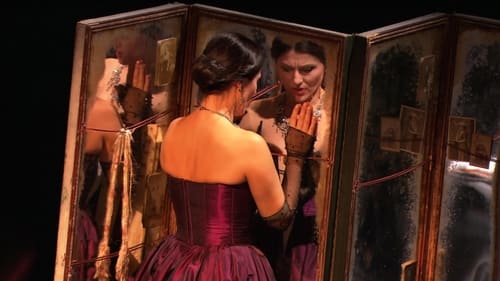
Rigoletto
궁중 광대 리골레토는 그의 주인인 공작의 방탕한 생활을 웃음소재로 삼으면서 실제 음탕한 행실을 능동적으로 돕기도 한다. 리골레토는 알아채지 못하는 사이에 집 안에 꽁꽁 숨겨두었던 자신의 딸 질다를 유괴해 공작에게 데려가는데 가담한다. 충격을 받은 리골레토는 공작의 이기적인 바람기를 벌하기 위해 암살자를 고용하고 상황은 예상치 못한 방향으로 전개된다.

Torn between his duty and paternal love, the Venitian doge is forced to exile his son accused of murder. Hopes to prove his innocence run high when his son returns home, but don’t discount their intriguing enemies just yet. I due Foscari sets out in despair and ends tragically. Its music, full of dark hues, awe-inspiring choruses and individual themes for the main characters, already paves the way for Verdi's later scores.

Prince Yeletsky
헤르만 장교는 ‘스페이드의 여왕’이라고 불리는 백작부인의 손녀 리자와 사랑하는 사이지만, 백작부인이 카드놀이에서 반드시 이기는 방법을 알고 있다는 이야기를 듣고는 그 비결을 알아내기 위해 백작부인에게 접근한다. 그 과정에서 부인이 갑작스런 충격으로 죽고, 리자는 배신감에 휩싸인다. 헤르만은 백작부인 유령으로부터 이길 수 있는 카드의 순서를 전수받고 도박장으로 달려가 처음 두 번은 성공하지만 마지막 게임에서 스페이드 퀸이 아닌 스페이드 에이스에 돈을 거는 바람에 모든 돈을 잃고 미쳐 버린다.

Giorgio Germont
사교계 여성 비올레타와 그를 연모하는 알프레도 제르몽의 가슴 아픈 비극적 사랑이야기이다. 사랑을 위해 자신을 희생하며 알프레도의 곁에 있는 비올레타에게 알프레도의 아버지가 찾아와 이별할 것을 강요한다. 눈물의 편지를 남기고 떠난 비올레타, 그리고 이 사실을 알지 못하는 알프레도는 그녀에게 복수하려고 다짐한다. 결국 이 모든 사실을 알게 되고 다시 그녀의 곁에 가지만, 알프레도에게 남은 것은 병으로 죽어가는 비올레타의 마지막 모습일 뿐인데...

Renato
Part of Tutto Verdi series - Un ballo in maschera (2011) Parma. Based on a Scribe libretto and begun as 'Gustavo III' set in Sweden, it became 'Una vendetta in dominò' set in Germany, and finally 'Un ballo', set not in Sweden but in Boston, Massachusetts during the colonial era. These changes were caused by a combination of censorship regulations in both Naples and Rome, as well as by the political situation in France in January 1858.

Don Carlo
Director Stefano Poda set the action in the mid 19th century. There’s not a piece of furniture in the whole show. Just a lot of slabs which change position as the opera progresses. There were also a lot of non-singing characters in strange poses who popped up here and there. This sort of staging is not the usual for the Parma house which typically stays close to the traditional. There’s nothing wrong with the staging that a first rate musical effort couldn’t overcome. But that effort was not forthcoming.

Giorgio Germont
Part of Tutto Verdi series - La Traviata (2007) Parma. 'La traviata' ('The Fallen Woman') is an opera in three acts by Giuseppe Verdi set to an Italian libretto by Francesco Maria Piave. It is based on 'La dame aux Camélias' (1852), a play adapted from the novel by Alexandre Dumas, fils. The opera was originally titled 'Violetta', after the main character. It was first performed on 6 March 1853 at the La Fenice opera house in Venice. Piave and Verdi wanted to follow Dumas in giving the opera a contemporary setting, but the authorities at La Fenice insisted that it be set in the past, "c. 1700". It was not until the 1880s that the composer and librettist's original wishes were carried out and "realistic" productions were staged.

The love between Sita, the priestess of the temple of Indra, and an unknown stranger, who is actually Alim the King of Lahore, is hindered by Scindia who wants to take the throne and to marry Sita. When Scindia discovers the lover's true identity, he accuses him before the high priest Timour, who condemnsns him to go into battle against the muslims. In the battle Alim is defeated, and, seriouslyy wounded, returns to Lahore where he ides in the arms of his beloved Sita. Having g risen in to the Hindu paradise and been reincarnated aim turns to Lahore just in time to witness the usurper's splendid coronation and to reveal Scindia's crimes to the entire populace, In the last act the two lovers take refuge in the temple of Indra to escape from Scindia: Sita takes her own life with a dagger thus provoking Alim's death. The two lovers will be together in the hereafter.







